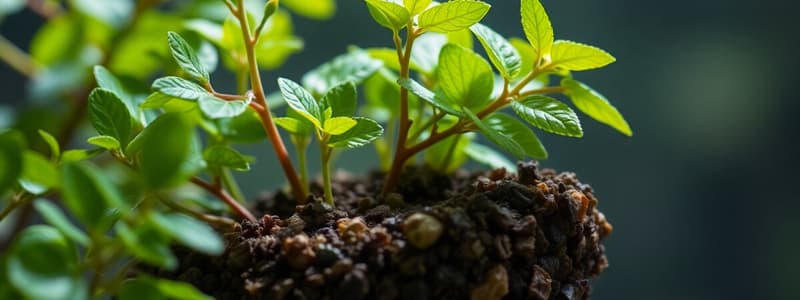Podcast
Questions and Answers
What is the primary function of chloroplasts in plant cells?
What is the primary function of chloroplasts in plant cells?
- Provide cell support
- Perform cellular respiration
- Store water
- Carry out photosynthesis (correct)
Which structure in chloroplasts contains chlorophyll?
Which structure in chloroplasts contains chlorophyll?
- Stroma
- Outer membrane
- Thylakoid membranes (correct)
- Cristae
What do vacuoles primarily store in plant cells?
What do vacuoles primarily store in plant cells?
- Glucose
- ATP
- Nutrients
- Water (correct)
What does the term 'powerhouse of the cell' refer to?
What does the term 'powerhouse of the cell' refer to?
During which season do plants have a high concentration of chlorophyll?
During which season do plants have a high concentration of chlorophyll?
What is the primary purpose of photosynthesis in plants?
What is the primary purpose of photosynthesis in plants?
Which of the following best describes cellular respiration?
Which of the following best describes cellular respiration?
What type of metabolic pathway is photosynthesis classified as?
What type of metabolic pathway is photosynthesis classified as?
Where does energy conversion occur during cellular respiration?
Where does energy conversion occur during cellular respiration?
What role do enzymes play in metabolic pathways?
What role do enzymes play in metabolic pathways?
Which of the following is true about chloroplasts?
Which of the following is true about chloroplasts?
Which statement correctly compares anabolic and catabolic pathways?
Which statement correctly compares anabolic and catabolic pathways?
How does cellular respiration differ from photosynthesis?
How does cellular respiration differ from photosynthesis?
Flashcards are hidden until you start studying
Study Notes
Photosynthesis
- Photosynthesis is a process used by plants and other producers to trap energy from the sun and convert it into glucose, an energy-rich carbohydrate
- It is an anabolic pathway that uses energy to build up complex molecules
- Occurs in chloroplasts
Cellular Respiration
- Cellular respiration is a catabolic pathway that releases energy by breaking down glucose
- It is performed by plants and animals (consumers)
- It occurs in mitochondria
- It generates ATP, the main energy carrying molecule for nearly all types of energy-requiring activities in living organisms
Anabolic and Catabolic Reactions
- Anabolic: Require energy and build large molecules (endothermic); Photosynthesis is anabolic because it makes glucose using the Sun’s energy
- Catabolic: Release energy and break down molecules (exothermic); Cellular respiration is catabolic because it breaks down glucose into ATP
Enzymes and Metabolic Pathways
- Enzymes are biological catalysts
- Enzymes reduce the activation energy needed for reactions in metabolic pathways
- Without enzymes, reactions couldn’t occur at temperatures at which living organisms thrive
Animal vs. Plant Cells
- Plant cells have three key organelles not found in animal cells:
- Vacuoles: Store water
- Chloroplasts: Perform photosynthesis
- Cell wall: Provides support
Chloroplasts
- Chloroplasts are membrane-bound organelles in green plant and algal cells that carry out photosynthesis
- They contain a system of flattened sacs called thylakoids
- Chloroplasts have:
- Two membranes
- Inner solution, called the stroma
- Stacks of thylakoids (granum = singular, grana = plural)
Chlorophyll
- Chlorophyll is a green pigment that traps solar energy and is bound to the thylakoid membrane
- Chlorophyll gives plants their green color
- Leaves, the primary photosynthetic organs of most plants, contain a high concentration of chlorophyll in the spring/summer
- In the cooler months, plants stop producing chlorophyll, causing the chlorophyll organs to break down and turn yellow, red, or brown
Mitochondria
- Mitochondria is the site of cellular respiration and is often referred to as the “powerhouse” of the cell
- Mitochondria:
- Are scattered throughout the cell’s cytoplasm
- Produce large amounts of ATP
- Have an inner and outer membrane surrounding the matrix (fluid-filled region that contains proteins to break down glucose)
- The inner membrane has deep infoldings called cristae, which increase the surface area for the production of ATP!
Studying That Suits You
Use AI to generate personalized quizzes and flashcards to suit your learning preferences.




